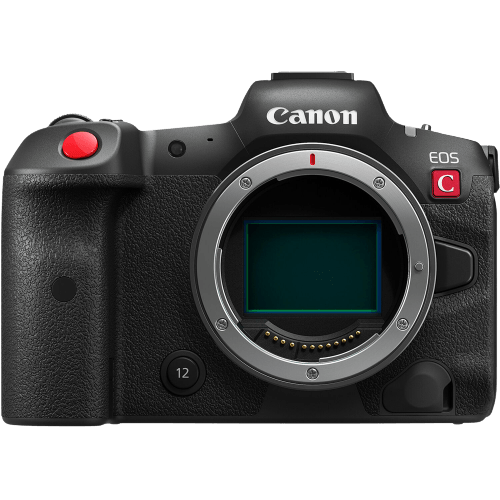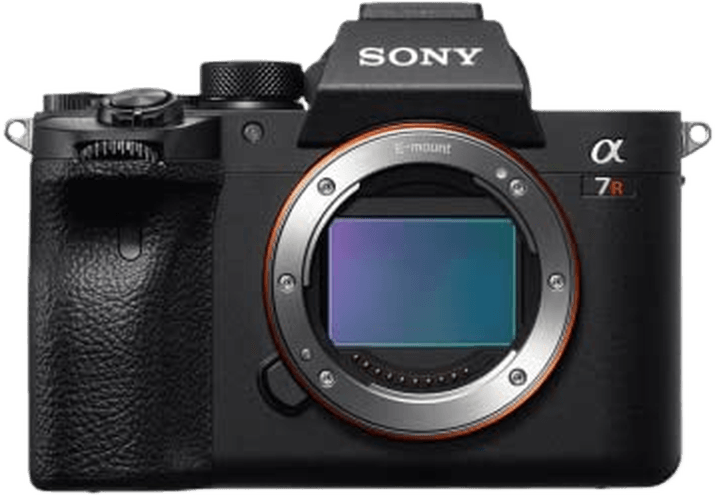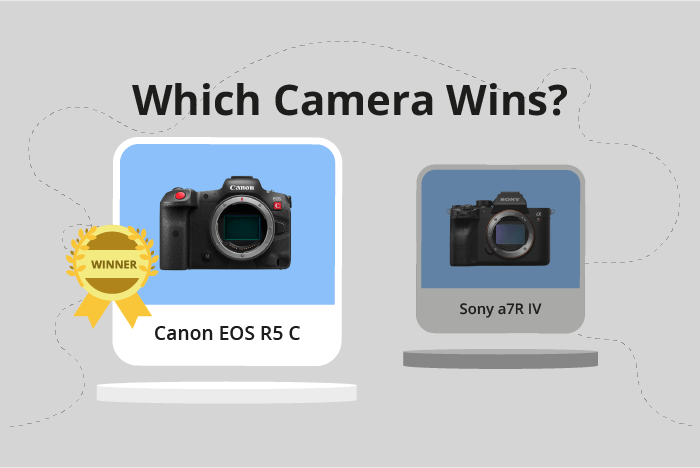Canon EOS R5 C vs Sony a7R IV Comparison
Canon EOS R5 C

Sony a7R IV

The Canon EOS R5 C outperforms the Sony a7R IV with a score of 87/100 compared to Sony’s 84/100. Both cameras are mirrorless and have similar dimensions, with the Canon being slightly larger and heavier. The Canon EOS R5 C was released in 2022, while the Sony a7R IV was launched in 2019.
The Canon EOS R5 C excels with its higher score and more recent release, offering advanced features and improved performance. However, the Sony a7R IV has the advantage of being lighter and more compact, making it easier to carry around. Additionally, the Sony camera is more affordable, with a launch price of $3500 compared to Canon’s $4499.
Considering these points, the Canon EOS R5 C is the superior camera in terms of performance and features, while the Sony a7R IV offers a more budget-friendly and portable option for photographers.
Canon EOS R5 C vs Sony a7R IV Overview and Optics
The Canon EOS R5 C outperforms the Sony a7R IV in optics, scoring 88/100 compared to Sony’s 85/100. Both cameras share several common specifications, including a full-frame CMOS sensor, image stabilization, and similar lens mounts with the Canon RF and Sony FE.
The Canon EOS R5 C surpasses the Sony a7R IV in several areas. With a shooting speed of 20 frames per second (fps), it doubles the Sony’s 10 fps, making it better suited for fast-action photography. The Canon’s Digic X processor is also more advanced than the Sony’s Bionz X, contributing to the camera’s overall performance and speed. Despite having a slightly lower DXOMARK score (97) for the sensor compared to the Sony (99), the Canon’s other superior features compensate for this difference.
However, the Sony a7R IV holds an advantage in terms of megapixels, boasting a 61.2-megapixel sensor compared to the Canon’s 45 megapixels. This allows the Sony to capture more detail and produce higher resolution images, which may be preferable for photographers who prioritize image quality over speed.
In comparing the optics of the Canon EOS R5 C and the Sony a7R IV, the Canon emerges as the winner due to its faster shooting speed and superior processor. While the Sony a7R IV has a higher megapixel count, the Canon’s overall performance makes it a better choice for most photographers. The Sony may still be a viable option for those who prioritize image resolution, but the Canon EOS R5 C provides a more well-rounded and versatile photographic experience.
Canon EOS R5 C vs Sony a7R IV Video Performance
The Canon EOS R5 C outperforms the Sony a7R IV in video capabilities, scoring 100/100 compared to the Sony’s 70/100. Both cameras share some common video features, such as built-in time-lapse functionality. However, the Canon EOS R5 C is superior in several key aspects.
The Canon EOS R5 C boasts a maximum video resolution of 8K, while the Sony a7R IV offers only 4K. This difference in resolution means the R5 C captures videos with significantly more detail and clarity. The Canon’s video dimensions are 8192 x 4320, compared to the Sony’s 3840 x 2160. This larger video dimension contributes to the R5 C’s ability to produce higher-quality videos.
Another advantage of the Canon EOS R5 C is its maximum video frame rate of 120fps. This is far superior to the Sony a7R IV’s 30fps, allowing the R5 C to record smoother and more fluid videos, especially in fast-paced or action-packed situations.
The Sony a7R IV, while not as powerful in video capabilities as the Canon EOS R5 C, still offers solid performance for those seeking a camera with 4K video and time-lapse functionality. Its 70/100 video score indicates that it is a capable camera for most users but may not satisfy those looking for higher video performance.
The Canon EOS R5 C is the clear winner in video capabilities, offering superior resolution, dimensions, and frame rate. While the Sony a7R IV provides adequate performance for many users, those seeking top-notch video quality will find the R5 C to be the better choice.
Canon EOS R5 C vs Sony a7R IV Features and Benefits
The Canon EOS R5 C wins the features comparison with a score of 87/100, while the Sony a7R IV scores 83/100. Both cameras share multiple specifications, including touchscreen capabilities, flip screens, absence of GPS, and the presence of WIFI and Bluetooth connectivity.
The Canon EOS R5 C excels with a larger screen size of 3.2 inches and a higher screen resolution of 2,100,000 dots. This advantage provides users with a clearer and more detailed display for image and video review. The larger screen size also enhances the user experience, allowing for easier navigation through menus and settings.
On the other hand, the Sony a7R IV has a smaller screen size of 3 inches and a lower screen resolution of 1,440,000 dots. While this is still a high-quality display, it falls short when compared to the Canon EOS R5 C. Despite this, the Sony a7R IV remains a strong competitor and may offer other advantages, such as a more compact design or a lower price point.
Both cameras have their strengths and weaknesses, but the Canon EOS R5 C takes the lead in terms of features. The larger screen size and higher resolution contribute to a superior user experience and image review process. However, the Sony a7R IV should not be dismissed, as it may provide other benefits depending on an individual’s preferences and needs. Ultimately, the choice between these two cameras will depend on the specific requirements and priorities of the user.
Canon EOS R5 C vs Sony a7R IV Storage and Battery
The Sony a7R IV outperforms the Canon EOS R5 C in storage and battery, scoring 79/100 compared to the Canon’s 68/100. Both cameras share similarities, such as two memory card slots and compatibility with USB charging. However, the Sony a7R IV has a significantly longer battery life of 670 shots, while the Canon EOS R5 C only offers 320 shots. This advantage makes the Sony a7R IV more suitable for extended shooting sessions.
The Canon EOS R5 C does have a slight edge in memory card compatibility, accepting both SD (UHS-II compatible) and CFexpress B cards. In contrast, the Sony a7R IV only accepts SD, SDHC, and SDXC (UHS-II compatible) cards. This difference may benefit some users who prefer CFexpress B cards for their workflow.
Despite the Canon EOS R5 C’s memory card advantage, the Sony a7R IV’s superior battery life makes it the better choice for photographers who prioritize longer shooting times. The Canon EOS R5 C is still a solid option for those who value CFexpress B card compatibility.
Canon EOS R5 C vs Sony a7R IV – Our Verdict
Are you still undecided about which camera is right for you? Have a look at these popular comparisons that feature the Canon EOS R5 C or the Sony a7R IV:

